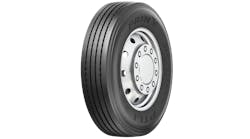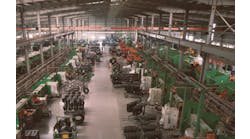The consensus coming from speakers at the 64th annual Tire Industry Association (TIA) Off-the-Road Tire Conference is that the economy is strong and prospects for growth in 2019 are expected. All of this spells moderate-to-strong demand for the OTR tire industry.
Ken Simonson, chief economist for the Associated General Contractors of America, told attendees that the U.S. economy is still growing well. He said that 304,000 jobs were added in January, making the total number of new jobs 2.8 million during the past 12 months, the most since 2015.
A recent survey done by the National Association for Business Economics (NABE) — an association for non-academic economists and other people who use economic information in the workplace — revealed that “the 280 respondents in general do not see any recession hitting in 2019, only 10% of them thought it possible. Forty-two percent do think there will be a recession in 2020, but another 25% think 2021, and the remainder think it will be after 2021,” said Simonson.
Indicators at both the consumer and business levels are generally high, with construction employment at an 11-year high. Simonson did mention that trade and fiscal policies continue to linger in the background, and there is a labor shortage for the construction industry. He said there were 382,000 job openings in construction at the end of December, more than double from the year prior.
Of this amount, contractors were only able to hire 219,000 employees in December. As MTD reported in our February issue, labor shortage issues are a major concern across the tire dealer community as well.
In looking forward, Simonson does not believe a federal infrastructure bill will be passed in 2019, but state highways funding and other projects, particularly in the public and private airport sectors, are growing substantially. He is expecting residential spending to grow in the 3% to 4% area for 2019, a slight downturn from 2018.
Kevin Rohlwing, senior vice president of training for TIA, looked at the mining industry expectations for 2019. He said that U.S. coal production actually declined in 2018 by 20 million short tons. Appalachian coal production increased, but interior and Western production declined. Rohlwing said the U.S. Energy Information Administration is predicting a decline of 3% in coal production for 2019.
Part of the reason for the decline is due to China’s decrease in importation of coal.Commodity pricing for aluminum, copper, nickel, zinc and iron ore held steady in 2018, according to Rohlwing, with all segments, except for iron ore, looking for a slight growth in 2019. Gold and silver pricing are both expected to increase between 7% and 10%, according to various sources that Rohlwing used for his research.
Rohlwing used part of his presentation to discuss Rare Earth Elements (REE) that are used for high tech devices such as magnets in cell phones, televisions, computers, automobiles, military equipment wind turbines and jet aircraft. In 2017, Rohlwing said that China produced 116.9 million tons, or 86.6%, of the global production of REEs.
According to a U.S. geological survey, America is 100% dependent of imports for the 17 different REEs. Rohlwing said the U.S. possesses 13% of known REE reserves, particularly in California, Alaska, Idaho, Montana and Missouri, but at the present time, no processing is being done here. The Mountain Pass area of California is extracting REEs, but had been shipping them to China for processing.
However, after being processed and shipped back to the U.S., the finished product is subject to tariffs. Rohlwing said Mountain Pass owners are planning to start domestic production in 2020. Canada is also looking to bring production to its country, with six projects to start in the 2020-2021 time frame.
A tire manufacturers’ panel discussion, moderated by MTD Publisher Greg Smith, presented a targeted look at how each manufacturer viewed the marketplace and what actions each company was taking to meet upcoming demand and issues facing them.
Bruce Besancon, vice president of sales, OTR tires, Yokohama Tire Corp., said that his company was seeing an upward trend in demand for OTR tires in the U.S. and Canada, probably in the 3% to 5% overall range, with stronger demand in certain categories.
Yokohama has expanded its field sales staff during the past year and has been increasing its product portfolio, having most recently launched a radial scraper tire line.Already a large player in the market, Besancon said the company is expanding its 33.00R51 as well as it 27.00R49 line of tires.
Doug Kershaw, vice president of BKT USA Inc., reported his company will be opening a new warehouse in the Midwest to improve delivery times and availability. He said the location has yet to be determined. From a product standpoint, Kershaw said his company is field-testing a 51-inch tire to be available later this year as well as a 57-inch tire that is in the works.
BKT is in the process of building a $23 million carbon black plant in Bhuj, India, as well as determining where to build a new $100 million manufacturing plant in the U.S. Kershaw pointed out that one of the challenges he sees for the industry right now is a severe labor shortage. This observation was shared by other panelists as well.
Ray McElroy, pneumatic segment manager, Trelleborg Wheel Systems Americas Inc., said his company continues to integrate CJS Holdings, producing the Mitas brand, into its portfolio of the EMR line of earthmover radials for work in quarries, pits and open mines. McElroy said the company’s bias line of tires will continue to be sold under the Mitas brand name.
The company intends to expand its training facility, which is based in its Akron, Ohio, warehouse.
Jimmy McDonnell, the vice president of sales and marketing for Maxam North America Inc., said that although the company has only been in North America for five years, they continue to be in an expansion mode. Maxam introduced 168 new items in 2018 and plans to introduce over 300 in 2019.
The company views 65-series tires as a big opportunity moving forward. McDonnell said his company is seeing supply issues on 29-, 33- and 35-inch rim sizes in the market at the present time.
Shawn Rasey, director, global business development, earthmover, Continental Tire of the Americas Inc., said his company has grown from four tire sizes in 2016, to over 100 line items currently. He said that the company’s Lousado, Portugal, plant continues to bring new tires online.
A big challenge for the industry continues to be the expansion of technology and having the ability to embrace it and move forward with it, Rasey said.
The session ended with the panelists taking a variety of questions from the attendees. A question regarding natural rubber prices allowed Besancon to issue a challenge, that had the audience in agreement (see sidebar).TIA released its OTR Tire and Rim Weight Charts during the conference. The tire charts feature both bias and radial tires. Both charts highlight the average weight, as well as the maximum weight. TIA collected data from multiple tire and wheel manufacturers and used thousands of data points to determine the average and maximum weights.
The OTR Tire and Rim Weight Charts include the maximum assembly weight so technicians can determine the approximate weight for the tire with and without the wheel. On larger assemblies, the individual rim components can weigh 100 pounds or more, which creates additional risk for the technician when they don’t know how much it weighs. All of the weights are listed in pounds and kilograms.
TIA also announced that next year’s OTR conference would be held at the Renaissance Indian Wells Resort near Palm Springs, Calif., from Feb. 19 to 22, 2020.
This year’s conference was attended by over 400 delegates from 40 states and 12 countries, according to information provided by TIA. There were roughly 50 different OTR dealers represented at the conference. ■




